Pyroelectric Energy Sensors (C-Series)

- Energy Ranges Covering 10 µJ to 15 J
- Wavelength Ranges Covering 185 nm to 25 µm
- Two Coating Options Available
- Red C-Series Connector Design for Quick Exchange
Sensors with Ceramic Coating
for High Energy Densities
Shown with
Included Isolator
ES220C
ES245C
Sensors with
Standard Coating
ES111C
ES120C
ES145C
Shown with Included Isolator

Please Wait
| Type | Broadband | Ceramic |
|---|---|---|
| Energy Range | 10 µJ - 2 J | 500 µJ - 15 J |
| Wavelength Range | 0.185 - 25 µm | 0.185 - 25 µm |
| Coating | Black Broadband Coating | Ceramic Coating with High Damage Thresholds |
| Typical Application | Wavelength-Independent Energy Measurements | High Energy Densities |
| Fiber Adapters | No | No |
Features
- For Pulsed Applications Over a Wide Wavelength and Energy Range
- Individually Calibrated with NIST- and PTB-Traceable Certificate of Calibration
- BNC Connector for Direct Use with Oscilloscopes
- Compatible with our C-Series Power Meters via BNC to C-Series Adapter
- Electrically Isolating Post Adapters Included
Thorlabs' Pyroelectric Energy Meter Sensors are sensitive to wavelengths from 185 nm to 25 µm and together span the energy range from 10 µJ to 15 J. All of these sensors provide a flat response over a large wavelength range. The ES220C and ES245C feature a ceramic coating that is specifically designed for lasers with high energy densities requiring high damage thresholds.
Compatibility
All the sensors listed here are compatible with the PM400, PM100D, PM320E, and PM100USB. Please note that they are not compatible with the PM100A. Alternatively, the sensors can be connected directly to an oscilloscope with a 1 MΩ input resistance via the BNC connector. To accommodate higher repetition rates when connected to oscilloscopes, the load resistance can be reduced. Calibration value for both 1 MΩ and 100 kΩ resistors are given with the sensor certificate of calibration.
The bottom of the sensor head has an 8-32 mounting hole. Since the heads are very sensitive to ground loops and electrical noise, we recommend attaching the heads to the included electrically isolating post adapters, which provide direct compatibility with either imperial or metric Ø1/2" (Ø12.7 mm) Posts. The ES120C and the ES220C can also be mounted to our 30 mm Cage System via the four 4-40 threaded holes on the front, although this mounting option does not provide electrical isolation.
Calibration
Each sensor head is individually calibrated and is shipped with a NIST- and PTB-Traceable Calibration Certificate. The calibration and identification data is stored in the BNC to C-Series adapter and is downloaded automatically when connected to the console.
Recalibration Services
Recalibration services are available for our power sensors, energy sensors, and consoles. We recommend recalibrating your Thorlabs sensor and console as a pair; however, each may be recalibrated individually. To order this service for your sensor or combined sensor and console, scroll to the bottom of the page and select Item # CAL-S200. To order this service for only your console, please contact Tech Support.
| Item # | ES111C | ES120C | ES145C | ES220C | ES245C |
|---|---|---|---|---|---|
| Technical Specs | |||||
| Detector Type | Standard Pyroelectric Energy Sensor | High Energy Pyroelectric Energy Sensor | |||
| Wavelength Range | 185 nm - 25 µm | 185 nm - 25 µm | |||
| Optical Energy Range | 10 µJ - 150 mJ | 100 µJ - 500 mJ | 500 µJ - 2 J | 500 µJ - 3 J | 1 mJ - 15 J |
| Max Repetition Rate (@ 1 MΩ Load) |
40 Hz | 30 Hz | 30 Hz | 30 Hz | 30 Hz |
| Max Power Density (Pulse Width) Range |
8 MW/cm² (10 ns Pulse) 185 nm - 25 μm |
65 MW/cm² (7 ns Pulse) 185 nm - 25 μm |
65 MW/cm² (7 ns Pulse) 185 nm - 25 μm |
||
| Max Pulse Energy Density (Pulse Width) Range |
0.15 J/cm² (1 µs Pulse) 185 nm - 25 μm |
0.45 J/cm² (7 ns Pulse) 185 nm - 25 μm |
0.45 J/cm² (7 ns Pulse) 185 nm - 25 μm |
||
| Max Average Powera | 0.15 W | 0.15 W | 0.5 W | 5 W | 10 W |
| Resolutionb | 100 nJ | 1 µJ | 1 µJ | 25 µJ | 50 µJ |
| Linearity | ±1% | ±1% | |||
| Measurement Uncertainty | ±5% | ±5% | |||
| Thermal Time Constant | 20 ms | 20 ms | |||
Sensor Connector
D-type Male

| Pin | Connection |
|---|---|
| 1 | +5 V (Drive Max: 50 mA) |
| 2 | EEPROM Digital I/O |
| 3 | Pyroelectric Sensor Ground |
| 4 | Not Used |
| 5 | Pyroelectric Sensor + |
| 6 | DGND |
| 7 | PRESENT [Connect This Pin through a 1 kΩ - 10 kΩ Resistor to Pin 3 (AGND)] |
| 8 | Not Used |
| 9 | Not Used |
Thorlabs offers a wide selection of power and energy meter consoles and interfaces for operating our power and energy sensors. Key specifications of all of our power meter consoles and interfaces are presented below to help you decide which device is best for your application. We also offer self-contained wireless power meters and compact USB power meters.
When used with our C-series sensors, Thorlabs' power meter consoles and interfaces recognize the type of connected sensor and measure the current or voltage as appropriate. Our C-series sensors have responsivity calibration data stored in their connectors. The console will read out the responsivity value for the user-entered wavelength and calculate a power or energy reading.
- Photodiode sensors deliver a current that depends on the input optical power and the wavelength. The current is fed into a transimpedance amplifier, which outputs a voltage proportional to the input current. The photodiode's responsivity is wavelength dependent, so the correct wavelength must be entered into the console for an accurate power reading. The console reads out the responsivity for this wavelength from the connected sensor and calculates the optical power from the measured photocurrent.
- Thermal sensors deliver a voltage proportional to the input optical power. Based on the measured sensor output voltage and the sensor's responsivity, the console will calculate the incident optical power.
- Energy sensors are based on the pyroelectric effect. They deliver a voltage peak proportional to the pulse energy. If an energy sensor is recognized, the console will use a peak voltage detector and the pulse energy will be calculated from the sensor's responsivity.
The consoles and interfaces are also capable of providing a readout of the current or voltage delivered by the sensor. Select models also feature an analog output.
Consoles
| Item # | PM100A | PM100D | PM400 | PM320E |
|---|---|---|---|---|
| (Click Photo to Enlarge) |  |
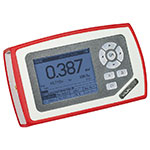 |
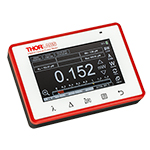 |
 |
| Key Features | Analog Power Measurements | Digital Power and Energy Measurements | Digital Power and Energy Measurements, Touchscreen Control | Dual Channel |
| Compatible Sensors | Photodiode and Thermal Power | Photodiode and Thermal Power; Pyroelectric | ||
| Housing Dimensions (H x W x D) |
7.24" x 4.29" x 1.61" (184 mm x 109 mm x 41 mm) |
7.09" x 4.13" x 1.50" (180 mm x 105 mm x 38 mm) |
5.35" x 3.78" x 1.16" (136.0 mm x 96.0 mm x 29.5 mm) |
4.8" x 8.7" x 12.8" (122 mm x 220 mm x 325 mm) |
| Channels | 1 | 2 | ||
| External Temperature Sensor Input (Sensor not Included) | - | - | Instantaneous Readout and Record Temperature Over Time | - |
| External Humidity Sensor Input (Sensor not Included) | - | - | Instantaneous Readout and Record Humidity Over Time | - |
| GPIO Ports | - | 4, Programmable | - | |
| Source Spectral Correction | - | - | - | |
| Attenuation Correction | - | - | - | |
| External Trigger Input | - | - | - | |
| Display | ||||
| Type | Mechanical Needle and LCD Display with Digital Readout | 320 x 240 Pixel Backlit Graphical LCD Display | Protected Capacitive Touchscreen with Color Display | 240 x 128 Pixels Graphical LCD Display |
| Dimensions | Digital: 1.9" x 0.5" (48.2 mm x 13.2 mm) Analog: 3.54" x 1.65" (90.0 mm x 42.0 mm) |
3.17" x 2.36" (81.4 mm x 61.0 mm) |
3.7" x 2.1" (95 mm x 54 mm) |
3.7" x 2.4" (94.0 mm x 61.0 mm) |
| Refresh Rate | 20 Hz | 10 Hz (Numerical) 25 Hz (Analog Simulation) |
20 Hz | |
| Measurement Viewsa | ||||
| Numerical | ||||
| Mechanical Analog Needle | - | - | - | |
| Simulated Analog Needle | - | |||
| Bar Graph | - | |||
| Trend Graph | - | |||
| Histogram | - | - | ||
| Statistics | ||||
| Memory | ||||
| Type | - | SD Card | NAND Flash | - |
| Size | - | 2 GB | 4 GB | - |
| Power | ||||
| Battery | LiPo 3.7 V 1300 mAh | LiPo 3.7 V 2600 mAh | - | |
| External | 5 VDC via USB or Included AC Adapter | 5 VDC via USB | Selectable Line Voltage: 100 V, 115 V, 230 V (±10%) | |
Interfaces
| Item # | PM101 | PM102 | PM101A | PM102A | PM101R | PM101U | PM102U | PM100USB |
|---|---|---|---|---|---|---|---|---|
| (Click Photo to Enlarge) |  |
 |
 |
 |
 |
 |
 |
 |
| Key Features | USB, RS232, UART, and Analog Operation |
USB and Analog SMA Operation | USB and RS232 Operation | USB Operation | USB Operation | |||
| Compatible Sensors | PM101 Series: Photodiode and Thermal Power PM102 Series: Thermal Power and Thermal Position & Power |
Photodiode and Thermal Power; Pyroelectric |
||||||
| Housing Dimensions (H x W x D) |
3.80" x 2.25" x 1.00" (96.5 x 57.2 x 25.4 mm) |
3.94" x 2.25" x 1.00" (100.0 x 57.2 x 25.4 mm) |
3.78" x 2.25" x 1.00" (95.9 x 57.2 x 25.4 mm) |
3.68" x 2.25" x 1.00" (93.6 x 57.2 x 25.4 mm) |
3.67" x 2.38 " x 1.13" (93.1 x 60.4 x 28.7 mm) |
|||
| Channels | 1 | |||||||
| External Temperature Sensor Input (Sensor Not Included) |
NTC Thermistor | - | ||||||
| External Humidity Sensor Input (Sensor not Included) |
- | |||||||
| GPIO Ports | - | |||||||
| Source Spectral Correction | - | |||||||
| Attenuation Correction | - | |||||||
| External Trigger Input | - | |||||||
| Display | ||||||||
| Type | No Built-In Display; Controlled via GUI for PC | |||||||
| Refresh Rate | Up to 1000 Hza | Up to 300 Hza | ||||||
| Measurement Viewsb | ||||||||
| Numerical | Requires PCb | |||||||
| Mechanical Analog Needle | - | |||||||
| Simulated Analog Needle | Requires PCb | |||||||
| Bar Graph | Requires PCb | |||||||
| Trend Graph | Requires PCb | |||||||
| Histogram | Requires PCb | |||||||
| Statistics | Requires PCb | |||||||
| Memory | ||||||||
| Type | Internal Non-Volatile Memory for All Settings | - | ||||||
| Size | - | |||||||
| Power | ||||||||
| Battery | - | |||||||
| External | 5 VDC via USB or 5 to 36 VDC via DA-15 |
5 VDC via USB | ||||||
Pulsed Laser Emission: Power and Energy Calculations
Determining whether emission from a pulsed laser is compatible with a device or application can require referencing parameters that are not supplied by the laser's manufacturer. When this is the case, the necessary parameters can typically be calculated from the available information. Calculating peak pulse power, average power, pulse energy, and related parameters can be necessary to achieve desired outcomes including:
- Protecting biological samples from harm.
- Measuring the pulsed laser emission without damaging photodetectors and other sensors.
- Exciting fluorescence and non-linear effects in materials.
Pulsed laser radiation parameters are illustrated in Figure 1 and described in the table. For quick reference, a list of equations are provided below. The document available for download provides this information, as well as an introduction to pulsed laser emission, an overview of relationships among the different parameters, and guidance for applying the calculations.
|
Equations: |
||||
 |
and |  |
||
 |
||||
 |
||||
 |
||||
Peak power and average power calculated from each other: |
||||
 |
and |  |
||
| Peak power calculated from average power and duty cycle*: | ||||
 |
*Duty cycle ( ) is the fraction of time during which there is laser pulse emission. ) is the fraction of time during which there is laser pulse emission. |
|||

Click to Enlarge
Figure 1: Parameters used to describe pulsed laser emission are indicated in the plot (above) and described in the table (below). Pulse energy (E) is the shaded area under the pulse curve. Pulse energy is, equivalently, the area of the diagonally hashed region.
| Parameter | Symbol | Units | Description | ||
|---|---|---|---|---|---|
| Pulse Energy | E | Joules [J] | A measure of one pulse's total emission, which is the only light emitted by the laser over the entire period. The pulse energy equals the shaded area, which is equivalent to the area covered by diagonal hash marks. | ||
| Period | Δt | Seconds [s] | The amount of time between the start of one pulse and the start of the next. | ||
| Average Power | Pavg | Watts [W] | The height on the optical power axis, if the energy emitted by the pulse were uniformly spread over the entire period. | ||
| Instantaneous Power | P | Watts [W] | The optical power at a single, specific point in time. | ||
| Peak Power | Ppeak | Watts [W] | The maximum instantaneous optical power output by the laser. | ||
| Pulse Width |  |
Seconds [s] | A measure of the time between the beginning and end of the pulse, typically based on the full width half maximum (FWHM) of the pulse shape. Also called pulse duration. | ||
| Repetition Rate | frep | Hertz [Hz] | The frequency with which pulses are emitted. Equal to the reciprocal of the period. | ||
Example Calculation:
Is it safe to use a detector with a specified maximum peak optical input power of 75 mW to measure the following pulsed laser emission?
- Average Power: 1 mW
- Repetition Rate: 85 MHz
- Pulse Width: 10 fs
The energy per pulse:

seems low, but the peak pulse power is:

It is not safe to use the detector to measure this pulsed laser emission, since the peak power of the pulses is >5 orders of magnitude higher than the detector's maximum peak optical input power.

Click to Enlarge
The PM160 wireless power meter, shown here with an iPad mini (not included), can be remotely operated using Apple mobile devices.
This tab outlines the full selection of Thorlabs' power and energy sensors. Refer to the lower right table for power meter console and interface compatibility information.
In addition to the power and energy sensors listed below, Thorlabs also offers all-in-one, wireless, handheld power meters and compact USB power meter interfaces that contain either a photodiode or a thermal sensor, as well as power meter bundles that include a console, sensor head, and post mounting accessories.
Thorlabs offers four types of sensors:
- Photodiode Sensors: These sensors are designed for power measurements of monochromatic or near-monochromatic sources, as they have a wavelength dependent responsivity. These sensors deliver a current that depends on the input optical power and the wavelength. The current is fed into a transimpedance amplifier, which outputs a voltage proportional to the input current.
- Thermal Sensors: Constructed from material with a relatively flat response function across a wide range of wavelengths, these thermopile sensors are suitable for power measurements of broadband sources such as LEDs and SLDs. Thermal sensors deliver a voltage proportional to the input optical power.
- Thermal Position & Power Sensors: These sensors incorporate four thermopiles arranged as quadrants of a square. By comparing the voltage output from each quadrant, the unit calculates the beam's position.
- Pyroelectric Energy Sensors: Our pyroelectric sensors produce an output voltage through the pyroelectric effect and are suitable for measuring pulsed sources, with a repetition rate limited by the time constant of the detector. These sensors will output a peak voltage proportional to the incident pulse energy.
| Console Compatibility | |||||||
|---|---|---|---|---|---|---|---|
| Console Item # | PM100A | PM100D | PM400 | PM320E | PM101 Series |
PM102 Series |
PM100USB |
| Photodiode Power |  |
 |
 |
 |
 |
- |  |
| Thermal Power |  |
 |
 |
 |
 |
 |
 |
| Thermal Position | - | - |  |
- | - |  |
- |
| Pyroelectric Energy | - |  |
 |
 |
- | - |  |
Power and Energy Sensor Selection Guide
There are two options for comparing the specifications of our Power and Energy Sensors. The expandable table below sorts our sensors by type (e.g., photodiode, thermal, or pyroelectric) and provides key specifications.
Alternatively, the selection guide graphic further below arranges our entire selection of photodiode and thermal power sensors by wavelength (left) or optical power range (right). Each box contains the item # and specified range of the sensor. These graphs allow for easy identification of the sensor heads available for a specific wavelength or power range.
| Photodiode Power Sensors |
|---|
| Thermal Power Sensors |
|---|
| Thermal Position & Power Sensors |
|---|
| Pyroelectric Energy Sensors |
|---|
Sensor Options
(Arranged by Wavelength Range)

Sensor Options
(Arranged by Power Range)


| Posted Comments: | |
启元 吴
(posted 2020-11-16 13:59:35.863) 工程师您好,我们于今年九月份购买了贵公司的ES245C型号的热释电能量探头,用于对脉冲激光能量的测试。但是收到的探头序号和我们之前的不一样,一个是C552,一个是C730。使用这两个不同的探头测得的数据也是不一样的。我们安装旧的探头的时候,量程选择为100mj、1J等。但是用新的探头的时候,量程选择是140mj、1.4j等,使用新的探头测量得到的数据是老的探头的1.4倍。所以想请教一下这个问题到底是为什么、该怎么进行校准? wskopalik
(posted 2020-11-16 06:26:50.0) Thank you very much for your inquiry!
The energy ranges which are shown on the power meter display will be slightly different for each sensor. It depends on the exact responsivity of the attached sensor which is determined in the calibration procedure. The shown range will e.g. also change, if the wavelength is changed. The measured values should however be the same on all attached sensors.
We will contact you directly to provide further assistance. Vladimir Makarov
(posted 2020-08-26 14:21:40.587) Hi,
I am using the ES220C to measure laser energy. I am using a pulsed laser at 1000 Hz frequency. On the oscilloscope the signal from ES220C looks like a sawtooth wave where the signal never reaches 0V, but goes up/down with the firing of each pulse in the pulse-train.
I understand this setup exceeds the repetition rate spec of 30Hz of this sensor. Can you explain if the total energy detected would be inaccurate? It seems the laser keeps adding heat/energy to the meter at a high frequency, so the meter should still integrate this energy, correct?
Best,
Vlad M dpossin
(posted 2020-08-28 05:04:35.0) Dear Vladimir,
Thank you for your feedback. Well, the fact that pyroelectric sensors can only see signal changes, the measurement of higher repetition rates leads to wrong energy measurements. The energy is measured via the the time it takes between an incoming pulse exceeding the set trigger level and reaching the peak. In case the repetition rate of the laser source exceeds the sampling rate of the detector, the detector stays armed all the time which most leads to wrong measurements. I am reaching out to you in order to provide further support. song wei
(posted 2019-03-22 15:15:05.84) ES220C能量计接到PM100D表头上怎么使用?为什么用了几次没有读数? How to use the ES220C with PM100D? Why there is no respondance during my measurements? swick
(posted 2019-03-28 06:28:23.0) This is a response from Sebastian at Thorlabs. Thank you for the inquiry.
Usage of ES220C with PM100D is Plug&Play. If you get no energy reading please check settings energy range and trigger level.
I contacted you directly for troubleshooting. Jack Grigor
(posted 2019-03-15 11:29:57.383) can you tell me the relevance of the absorption graph shown for the ceramic coated ES245C detector? The specification quotes a measurement uncertainty of+/- 5% from 185 nm to 25 um, how does the absorption of the ceramic coating affect that when it drops by about 20% shortly after 1000nm? Does the detector responsivity not change at those longer wavelengths?
Thanks in advance. nreusch
(posted 2019-03-19 06:02:23.0) This is a response from Nicola at Thorlabs. Thank you for your inquiry! Generally speaking, a low responsivity of a detector system for certain wavelength ranges can lead to a reduced accuracy in this range. This is, however, only relevant if the responsivity is reduced by a lager factor. For e.g. our photodiode sensors, we specify different uncertainties for different wavelength ranges (3%, 5% or 7%). The 5% measurement uncertainty for ES245C is valid across the whole wavelength range. Bruce Melcher
(posted 2019-03-13 10:24:47.53) Is the ES220C sensor fast enough to respond to a single 7ns pulse at a 6mJ power level?
We are firing a single shot, 7ns, 6mJ, 1570nm Laser pulse into the ES220C sensor. We "appear" to get nothing but noise as an output (less than 1 mV). nreusch
(posted 2019-03-19 08:24:22.0) This is a response from Nicola at Thorlabs. Thank you for your inquiry. Pyroelectric sensors can resolve single pulses as long as the pulse energy is within the specified range. Please double check that the trigger level and the energy range are set correctly. We will contact you directly to provide further assistance. j.t.m.dehaas
(posted 2016-08-04 08:53:32.52) What is the input resistance of the BNC to DB9 mating adapter?
In other words what is the max. repetition rates of the sensor + the adapter?
Best regards
Johan swick
(posted 2016-08-04 06:00:28.0) This is a response from Sebastian at Thorlabs. Thank you very much for your inquiry.
The input resistance of the BNC-DB9 adapter is quite low and has no measurable effect on the repetition rate. The load resistance of our power meter consoles is 1MOhm, so with our power meter consoles (PM200, PM100D, PM100USB and PM320) and ES111C the maximum achievable repetition rate is 40Hz.
If the signal from ES111C is recorded with an other device than our power meter consoles, the maximum repetition rate (with 50kOhm) would be 100Hz. yuansuochao
(posted 2014-04-29 15:25:49.493) ES120C和145C能量计接到PM200表头上怎么使用?为什么用了几次没有读数?
How to use the ES120C with PM200? Why there is no respondance during my measurements? shallwig
(posted 2014-04-30 07:06:48.0) This is a response from Stefan at Thorlabs. Thank you very much for your inquiry. I am really sorry that you are experiencing difficulty with our ES120C sensor in combination with the PM200 power meter. These two units work together, perhaps the settings of the trigger level are not correct. If it is set too high the pulses will not be recognized by the device. On page 31 in the manual http://www.thorlabs.com/thorcat/19300/PM200-Manual.pdf we describe how to change this setting. In order to troubleshoot where your measurement problems come from and how to solve them I will contact you directly. sergii.yakunin
(posted 2013-10-16 09:19:32.03) Will ES111C head work with optically chopped CW light? tschalk
(posted 2013-10-16 11:18:00.0) This is a response from Thomas at Thorlabs. Thank you very much for your inquiry. An energy Sensor is not designed to work with a chopped light source. Therefore photo diodes or thermal sensors would be a better solution. I will contact you directly to discuss your application. julien
(posted 2011-01-28 04:50:28.0) A response from Julien at Thorlabs: Thank you for your feedback. The specification of the pulse length for the 150mJ/cm2 value is wrong and will be changed immediately. This max energy density corresponds to the maximum energy for long pulses (>1µs). Above this value the heat increase will bring the sensor above its Curie temperature and thus hamper its proper functioning. The curve in the spec sheet corresponds to the damage threshold of the adsorber surface. When damaged, the absorption of this surface will change and the responsivity of the sensor will be modified accordingly. matthew.bergkoetter
(posted 2011-01-26 16:26:55.0) The max pulse energy density for the ES111C is specified here on the webpage as 0.15J/cm2 for a 10ns pulse at 1064nm, however the PDF spec sheet seems to contradict this. Based on the plot titled "Pulse Energy Ratings and Damage Thresholds", the max energy density for a 10ns pulse would be more like 2mJ/cm2 - a discrepancy of two orders of magnitude. Which is correct? user
(posted 2010-09-21 05:45:39.0) Answer from Angelika at Thorlabs: The specification "max repetition rate" refers to the maximum data acquisition rate of the sensor. It is defined by the time constant of the sensor (time required to reach the initial sensor properties after a pulse). user
(posted 2010-09-10 06:44:52.0) Does the maximum repetition rate for the ES111C of 40Hz refer to the maximum data acquisition rate of the sensor or the maximum repetition rate of the laser to avoid damage to the sensor? julien
(posted 2010-08-11 12:30:55.0) A response from Julien at Thorlabs: the wavelength dependence of the damage threshold is related to absorption of the surface coating. As can be seen in the tab absorption graph, the absorption of the ES100 series is almost wavelength independent. The damage threshold specified can be thus used over the whole wavelength range of those sensors. user
(posted 2010-08-10 23:32:52.0) the Max Pulse Energy Density of ES111C is specified with 7ns pulse but at what wavelength? |


Click to Enlarge
ES220C Sensor Mounted in a 30 mm Cage System
- For General Purpose and High Energy Optical Pulse Measurements
- Black Broadband Coating with Flat Response Over a Wide Wavelength Range
- Ceramic Coating with High Damage Thresholds for High-Energy-Density Lasers
- Sensor Areas from Ø11 mm to Ø45 mm Sensor Area
- BNC Connector for Oscilloscope Use
- Includes C-Series Connector Adapter for Use with Compatible Thorlabs Consoles (See Table Below)
The ESxxxC Standard and High Energy Pyroelectric Sensors are designed to measure pulsed coherent and incoherent sources. Pyroelectric sensors are not suited for CW measurements, as they convert energy from light pulses into voltage pulses. A black broadband or ceramic coating is used for low or high power measurements, respectively. Large sensor areas from Ø11 mm to Ø45 mm allow easy alignment. The energy sensors features BNC connectors for use with an oscilloscope, as well as standard power meter connectors which contain NIST and PTB-traceable calibration data.
Thorlabs offers a recalibration service for these energy sensors, which can be ordered below (see Item # CAL-S200).
| Item #a | ES111C | ES120C | ES145C | ES220C | ES245C |
|---|---|---|---|---|---|
| Sensor Image (Click the Image to Enlarge) |
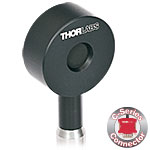 |
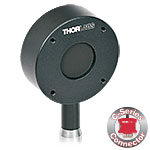 |
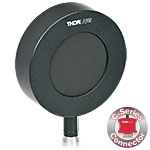 |
 |
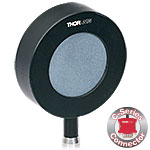 |
| Input Aperture Size | Ø11 mm | Ø20 mm | Ø45 mm | Ø20 mm | Ø45 mm |
| Wavelength Range | 0.185 - 25 µm | ||||
| Energy Range | 10 µJ - 150 mJ | 100 µJ - 500 mJ | 500 µJ - 2 J | 500 µJ - 3 J | 1 mJ - 15 J |
| Detector Type | Pyroelectric Energy Sensor with Black Broadband Coating | Pyroelectric Energy Sensor with Ceramic Coating | |||
| Resolution | 100 nJ | 1 µJ | 1 µJ | 25 µJ | 50 µJ |
| Linearity | ±1% | ||||
| Measurement Uncertainty | ±5% @ 0.185 - 25 µm | ||||
| Housing Dimensions | Ø36 mm x 16 mm | Ø50 mm x 18 mm | Ø75 mm x 21 mm | Ø50 mm x 18 mm | Ø75 mm x 21 mm |
| Active Detector Area | 95.0 mm2 | 314.2 mm2 | 1590.4 mm2 | 314.2 mm2 | 1590.4 mm2 |
| Cable Length | 1.5 m | ||||
| Post Mounting | 8-32 Mounting Thread, 8-32 and M4 Insulating Adapters Included | ||||
| Cage Mounting | N/A | Four 4-40 Threadings for 30 mm Cage Systems |
N/A | Four 4-40 Threadings for 30 mm Cage Systems |
N/A |
| Compatible Consoles | PM400, PM100D, PM100USB, and PM320E | ||||

| Sensor Type | Sensor Item #s |
|---|---|
| Thermal Power | S175C, S302Ca, S305Ca, S310Ca, S314Ca, S322C, S350C, S370C, S401C, S405C, S415C, S425C, S425C-L, S470C |
| Pyroelectric Energy | ES111C, ES120C, ES145C, ES220C, ES245C |
Thorlabs offers recalibration services for our thermal power and pyroelectric energy sensors. To ensure accurate measurements, we recommend recalibrating the sensors annually. Recalibration of the console is included with the recalibration of a sensor at no additional cost. If you wish to recalibrate only your power meter console, please contact Tech Support for details.
The table to the right lists the sensors for which this calibration service is available. Please enter the Part # and Serial # of the sensor that requires recalibration prior to selecting Add to Cart.
 Products Home
Products Home



























 Pyroelectric Energy Sensors
Pyroelectric Energy Sensors